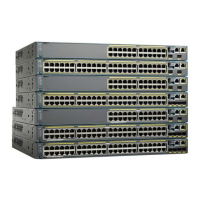Attribute [64] must contain the value VLAN (type 13). Attribute [65] must contain the value 802 (type
6). Attribute [81] specifies the VLAN name or VLAN ID assigned to the IEEE 802.1x-authenticated user.
802.1x Authentication with Per-User ACLs
You can enable per-user access control lists (ACLs) to provide different levels of network access and service
to an 802.1x-authenticated user. When the RADIUS server authenticates a user connected to an 802.1x port,
it retrieves the ACL attributes based on the user identity and sends them to the switch. The switch applies the
attributes to the 802.1x port for the duration of the user session. The switch removes the per-user ACL
configuration when the session is over, if authentication fails, or if a link-down condition occurs. The switch
does not save RADIUS-specified ACLs in the running configuration. When the port is unauthorized, the
switch removes the ACL from the port.
You can configure router ACLs and input port ACLs on the same switch. However, a port ACL takes precedence
over a router ACL. If you apply input port ACL to an interface that belongs to a VLAN, the port ACL takes
precedence over an input router ACL applied to the VLAN interface. Incoming packets received on the port
to which a port ACL is applied are filtered by the port ACL. Incoming routed packets received on other ports
are filtered by the router ACL. Outgoing routed packets are filtered by the router ACL. To avoid configuration
conflicts, you should carefully plan the user profiles stored on the RADIUS server.
RADIUS supports per-user attributes, including vendor-specific attributes. These vendor-specific attributes
(VSAs) are in octet-string format and are passed to the switch during the authentication process. The VSAs
used for per-user ACLs are inacl#<n> for the ingress direction and outacl#<n> for the egress direction. MAC
ACLs are supported only in the ingress direction. The switch supports VSAs only in the ingress direction. It
does not support port ACLs in the egress direction on Layer 2 ports.
Use only the extended ACL syntax style to define the per-user configuration stored on the RADIUS server.
When the definitions are passed from the RADIUS server, they are created by using the extended naming
convention. However, if you use the Filter-Id attribute, it can point to a standard ACL.
You can use the Filter-Id attribute to specify an inbound or outbound ACL that is already configured on the
switch. The attribute contains the ACL number followed by .in for ingress filtering or .out for egress filtering.
If the RADIUS server does not allow the .in or .out syntax, the access list is applied to the outbound ACL by
default. Because of limited support of Cisco IOS access lists on the switch, the Filter-Id attribute is supported
only for IP ACLs numbered 1 to 199 and 1300 to 2699 (IP standard and IP extended ACLs).
The maximum size of the per-user ACL is 4000 ASCII characters but is limited by the maximum size of
RADIUS-server per-user ACLs.
To configure per-user ACLs:
•
Enable AAA authentication.
•
Enable AAA authorization by using the network keyword to allow interface configuration from the
RADIUS server.
•
Enable 802.1x authentication.
•
Configure the user profile and VSAs on the RADIUS server.
•
Configure the 802.1x port for single-host mode.
Per-user ACLs are supported only in single-host mode.Note
Catalyst 2960-X Switch Security Configuration Guide, Cisco IOS Release 15.0(2)EX
280 OL-29048-01
Configuring IEEE 802.1x Port-Based Authentication
802.1x Authentication with Per-User ACLs
